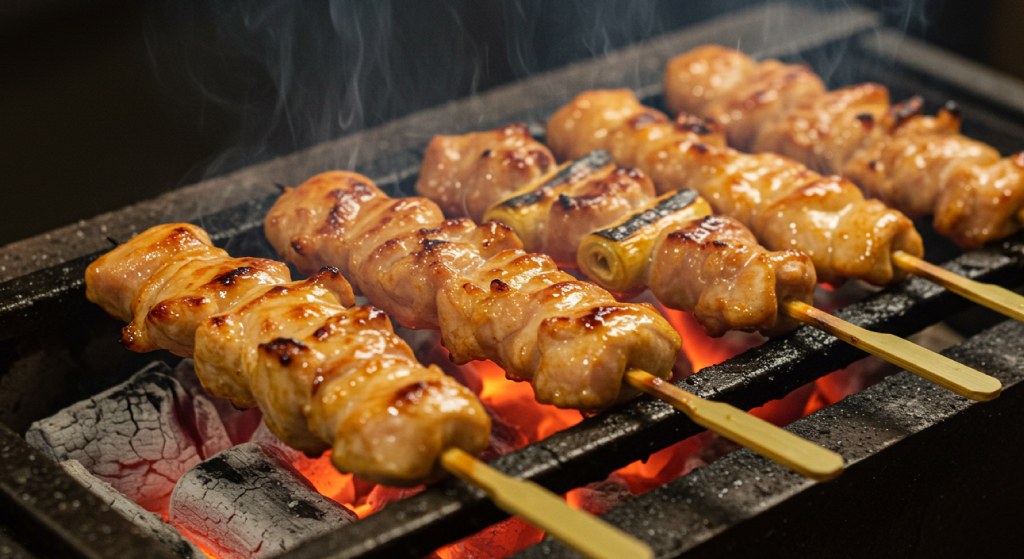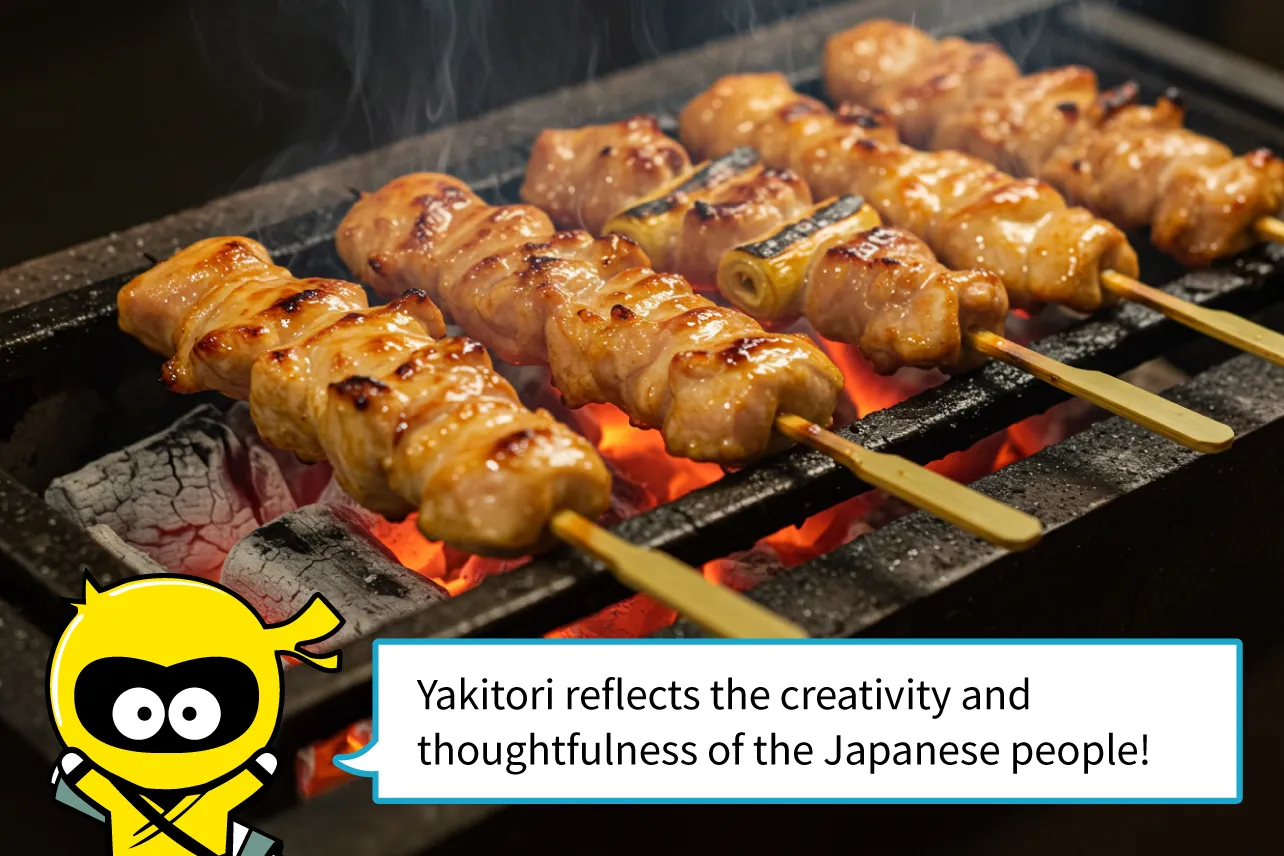

What Is Japanese Yakitori?
Yakitori is a beloved Japanese dish commonly found at izakayas (Japanese-style pubs). It consists of bite-sized pieces of chicken skewered on bamboo sticks and grilled over charcoal. The meat is typically seasoned with either a sweet-savory soy-based sauce (tare) or simply with salt. One of the charms of yakitori is the variety—it includes cuts like thigh (momo), chicken and scallion (negima), meatballs (tsukune), crispy skin (kawa), and more. In Japan, yakitori is traditionally eaten straight from the skewer, which is believed to be the most delicious way to enjoy it. Japanese diners also appreciate the visual presentation and careful grilling, both of which are integral to the yakitori experience.
Eating Yakitori on the Skewer: The Basic Japanese Manners


The golden rule when enjoying yakitori in Japan is to eat it directly from the skewer. This isn’t just tradition—it’s how the flavor and texture are best preserved. Yakitori is carefully grilled to be delicious as-is, and removing the meat can disrupt its intended taste. Additionally, eating yakitori straight from the skewer is seen as respectful and considerate in Japanese culture. If a visitor removes the meat before eating, it may surprise Japanese locals. Embracing this custom while traveling enhances not just your meal but your entire cultural experience in Japan.
Why Yakitori Tastes Better on the Skewer
There’s a scientific and culinary reason why Japanese yakitori tastes better when eaten on the skewer. Grilling meat while it’s skewered allows heat to distribute evenly, locking in juices and enhancing flavor. Bamboo skewers also impart a subtle aroma that contributes to the overall taste. Yakitori chefs in Japan meticulously grill each skewer with precision, balancing temperature and timing. By eating the meat directly off the stick, you enjoy the yakitori exactly as it was crafted to taste.
Is It Rude to Remove the Meat? Common Izakaya Etiquette Mistakes
In a Japanese izakaya, removing meat from yakitori skewers—especially when eating by yourself—can be perceived as inconsiderate. Some chefs, known for their dedication, may see this as a disruption of the perfect grilling they’ve achieved. Disassembling skewers onto a plate can also appear messy and unpleasant to other diners. Understanding and respecting this etiquette helps you have a smoother, more enjoyable dining experience during your stay in Japan.
How Skewers Help Balance Flavor and Texture


The skewer is more than just a serving stick—it’s a tool that creates the ideal cooking conditions for yakitori. Grilling on skewers ensures that both the outside and inside of the meat are evenly cooked. It also keeps the pieces packed closely together, preventing moisture loss and enhancing umami. Simply put, yakitori tastes better when eaten on the skewer because the flavor and texture are carefully calculated from preparation to plate. Once you know this, you may never want to remove the meat again.
When Is It Okay to Remove Yakitori from the Skewer?
If you’re dining in a group and want to share yakitori, removing the meat can be acceptable—but it’s important to do it properly. Use shared tongs or chopsticks to remove the meat and avoid touching others’ utensils. Be gentle so you don’t damage the carefully grilled meat. In Japan, how you serve others is part of good manners, so showing respect in your actions is appreciated. If you’re unsure, simply ask before removing anything—considerate behavior is always welcomed in Japanese culture.
Common Mistakes Foreign Visitors Make and How Japanese People React
A frequent mistake foreign visitors make is immediately removing the meat from the skewers. While this might be common in other countries, it can feel unusual in Japan, especially at specialty yakitori restaurants or high-end izakayas where eating from the skewer is the norm. Japanese people are generally understanding, but they may be surprised or slightly uncomfortable. Learning about this simple custom in advance helps you navigate local dining scenes with confidence and cultural awareness.
A Guide to Yakitori Types and How to Enjoy Them
Yakitori comes in many delicious varieties. Popular choices include juicy thigh (momo), savory negima (chicken and green onion), springy meatballs (tsukune), crispy chicken skin (kawa), and flavorful organ meats like liver (reba) and heart (hatsu). Each cut is seasoned and grilled to bring out its best qualities. No matter the type, yakitori is generally best eaten directly from the skewer—especially when it’s coated in a rich tare sauce that clings to the meat. Understanding the different parts will help you enjoy yakitori like a local.
You might be interested in this
Where to Enjoy Authentic Skewer-On Yakitori in Japan
Across Japan, you’ll find countless yakitori spots that serve skewers the traditional way. Tourist hotspots like Tokyo’s Shinjuku and Shibuya, Osaka’s Dotonbori, and Kyoto’s Pontocho offer excellent yakitori restaurants that often have English menus. Choose places where skilled chefs grill each skewer to order—you’ll truly experience how much better yakitori tastes when you eat it on the skewer. Make it part of your trip and savor the unique flavors of Japanese street food done right.
Quick Tips to Enjoy Yakitori in Japan
To make the most of your yakitori experience in Japan, keep a few simple tips in mind. First, remember that eating yakitori on the skewer is not only polite but also the most delicious way to enjoy it. If you need to share, do so respectfully and without touching others’ chopsticks. Yakitori is more than a snack—it’s a cultural experience that showcases the skill and care of Japanese chefs. Understanding that “yakitori tastes better on the skewer” will elevate your dining and leave you with lasting memories of Japan.




